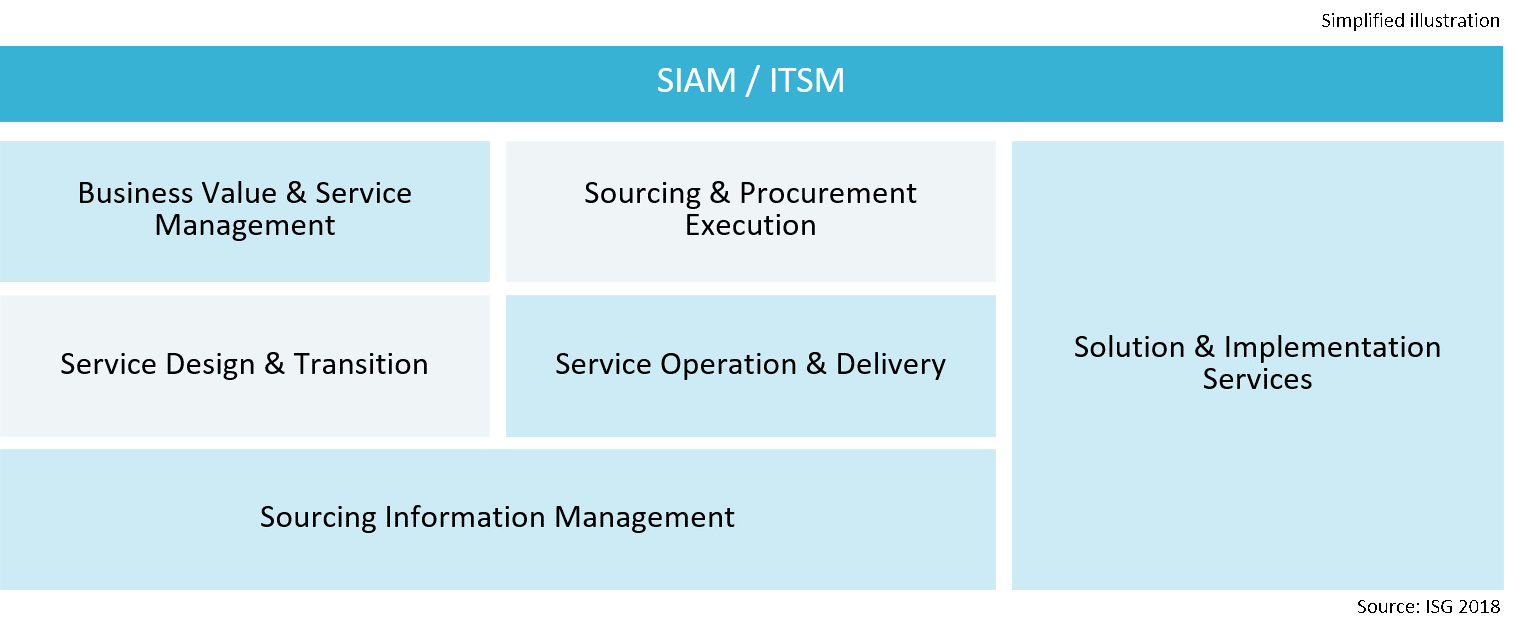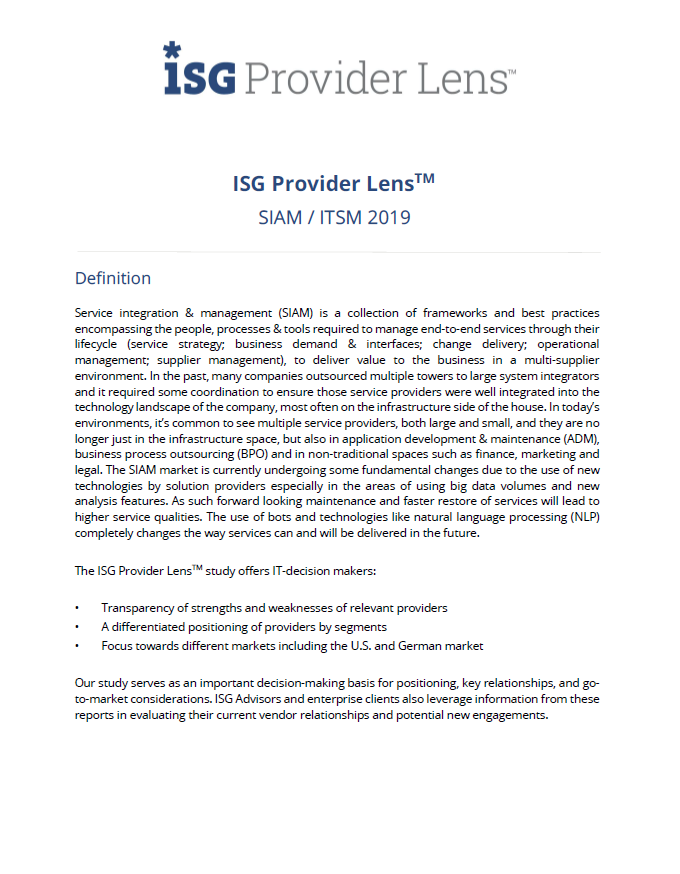ISG Provider Lens™ Research (Archetype & Quadrant) are dedicated studies of relevant offerings related to specific IT or BPO topics or service lines over multiple regions (see “IPL Project Plan” for details). Leading vendors and service providers are evaluated and positioned, based on a transparent methodology.
The studies provide IT vendors and providers an informed base of data and research to enable them to compare their own offerings with those of relevant competitors and to reveal strengths and weaknesses as well as competitive differentiators and unique selling points. Our study serves as an important decision-making basis for positioning, key relationships, and go-to-market considerations. ISG Advisors and enterprise clients also leverage information from these reports in evaluating their current vendor relationships and potential new engagements.
Vendor positioning is based on a neutral and independent research and evaluation process. Participation in the study is FREE OF CHARGE. Vendors can purchase reprint rights of the study for marketing, press and sales purposes only AFTER the study has been completed.
A project brochure with further information can be obtained by clicking on the following graphic:
Definition of Quadrants (market categories)
Below you will find the detailed definitions of the market categories evaluated in the study "SIAM / ITSM 2019". As part of the ISG Provider LensTM Quadrant Study, we are introducing the following 6 quadrants:

Segments Description
Solution & Implementation Services
A key challenge for IT customers is the implementation and maintenance of tools and solutions in the complex process set-up of IT Service Management. Tools are available but due to the uniqueness of each client situation the implementation and maintenance of such solutions often overstrains the user organizations. System Integrators and other solution partners are often tasked to support IT clients when transforming the management approach. The goal of such transformations is a high degree of automation paired with robust but flexible process blueprints. Minimizing manual tasks in operating complex IT environments is more important than ever as the requests for change that are coming from the Business Units are increasing in amount and complexity. While the Digital Transformation of the companies requires a new dimension in flexibility when implementing new business solutions, IT still must ensure a continuously running infrastructure. So, the use of IT4IT paired with the complex delivery ecosystem is a growing challenge for most user organizations. System Integrators and other support and consulting organizations are required to support the client in ensuring that quality of service.
In this quadrant we are comparing those organizations that support clients through dedicated services. The offerings range from assessments to design and implementation consulting to full scale implementation and operation services. The knowledge of the resources and the breath of solutions support are key criteria when comparing such organizations.
Business Value & Service Management
This quadrant scopes on the outbound and forward-looking processes of IT service management as well as the more managerial issues. Understanding the client’s demand and generating and managing the service portfolio is the heart of this quadrant. Financial management processes and customer satisfaction are part of this group as they require direct client access and feedback as well. The process set is being grouped in four process clusters:
- Managing the service demand of the clients through demand forecasting, financial and consumption management, financial planning and chargeback and show back activities
- Managing the service portfolio and the related service catalogue
- Dealing with “regular” service requests and managing the non-standard requests
- The full management of the complete Customer Satisfaction process
One focus of this quadrant is the use of Social Media to enhance the level of communication between IT and their clients. Customer Satisfaction will use the information from the social media channels to automatically come up with information about the status. Turning data into information with the use of AI and big data will support the financial analysis and chargeback process. Seamless integration of the various processes will lead to a much more customer-oriented service portfolio management putting the client into the center of the activities.
Sourcing & Procurement Execution
This quadrant addresses two areas of important activities: managing the sourcing lifecycle that leads into those processes required for procuring any third-party delivery – products or services
The sourcing lifecycle is defined as all processes required to
- define a souring strategy
- and execute a sourcing event.
Procurement activities cover everything from ordering a product to receiving the items to invoice checking to payment for the sourcing part of the study we will analyze companies that provide automation tools for the processes necessary to execute the full sourcing lifecycle from sourcing strategy execution all the way to contract signature (source-to-contract). Those products shall as much as possible automate the full RfX cycle, vendor analysis and selection as well as contract design and delivery Mainly a document management activity solution in this area must provide strong workflow management with auditable results. In addition, integration capabilities into associated processes such as Vendor and Contract Management are required. Procurement Execution is the next process set required so a seamless integration with the sourcing execution is necessary. The tools and solutions we will analyze need to provide two sets of functionalities:
- the use of a business network to electronically communicate and manage a supply market
- process automation to manage the procure-to-pay process.
Service Operation & Delivery
This quadrant addresses the areas of IT service operations and delivery to the end client. Service operations is the area of processes that are needed to deliver defined IT services to the end client in a robust manner. The processes focus on 3 areas:
- Event and incident management to automatically recognize what is happening in the environment that needs to be managed
- Problem Management including User Helpdesk to manage the process of finding and fixing problems and communicate with the client
- Post-event area that includes reporting, SLA management to ensure quality of the service delivered and to continuously improve that quality
In addition, the Facility Management is part of this process group. Besides the more “classical” automation of process functions this area of the solution market is currently undergoing a fundamental change due to the enhanced technical capabilities available. Especially big data and analytics paired with artificial intelligence and cognitive computing offer a wide range of enhanced functionalities that allow for much higher automation. IoT and smart metering plus intelligent sensors allow vendors to offer products that enable their customers to establish services that ultimately will lead to personalized, continuously available services. ISG’s clients that are currently looking for products and solutions in this market or are already active in that space will in average double their investments for the new technologies like RPA, Autonomics, Virtual Customer Agents, Natural Language Processing and Machine Learning. In this market segment we see companies
- that build the tools and provide the solution either through a classical on-premise installation or as SaaS delivery models
- that build the tools and provide the solution as a pure play SaaS environment
- that utilize existing solutions and provide the implementation services dedicated to this Solution
- that utilize existing solutions, develop specific extensions and provide implementation services for a variety of solutions.
Service Design & Transition
This quadrant addresses the areas of IT service design and service transition into operations. While service design is mainly addressing the planning topics such as required service availability and capacity as well as service continuity and security issues the transition part looks at three key areas:
- the transition of a service from planning into operation with change and change evaluation management
- the validation of changes and services
- the necessary processes to deploy a change or service and the management of the various release levels
In this part of the IT SIAM framework integration with the BVSM is essential to design services aligned with customer needs. BVSM as the direct interface and “product marketing” of the IT service organization delivers the information about customer satisfaction with current services and new demand. The use of historical and current information about the service consumption is essential to design and build the services. Reporting and AI paired with big data and analysis will be required in the future. New technologies will support clients when dealing with the “go-live” activities of new or updated services. Machine learning and AI will help clients in the future to better understand implications of changes to avoid any drawbacks on existing services. In this market segment we see companies
- that build the tools and provide the solution either through a classical on-premise installation or as SaaS delivery models
- that build the tools and provide the solution as a pure play SaaS environment
- that utilize existing solutions and provide the implementation services dedicated to this Solution
- that utilize existing solutions, develop specific extensions and provide implementation services for a variety of solutions.
Sourcing Information Management
Implementations and operations of IT services is only as good as the information base on which all process automation is being build. In this quadrant we focus on the information management framework. Key is building and maintaining the Configuration database as it forms the heart of the information framework. While building the database is one thing that must use technologies to support the IT personal through intelligent auto discovery maintaining the database historically was the bigger issue. After a CMDB has been designed, built and populated it was already outdated when it went live. Social media, NLP and artificial intelligence paired with machine learning and enhanced sensoring will be used in the future to keep such databases mostly automatically in a current state.
Consequently, tools that support processes such as asset management and identity & access management are part of this information management quadrant. Most of this data are attached to objects in the CMDB anyway so intelligent grouping and data extraction will provide functionalities to support these activities. Finally, knowledge and data management are using the underlying information to draw conclusions and feed operational processes and increase and keep the quality of data. While these areas of the operations framework where pretty much neglected in the past as they do not deliver any monetary benefits at all they become more and more important for the new, data-driven process framework. IT clients have burned their fingers in the past as the required co-operation from the IT user side was not a given and IT wasn’t able to keep the data up-to-date on their own. As such the use of new technologies such as AI will help to execute such process in a much more qualitative way. In this quadrant we will mainly focus on vendors that build applications for process automation on top of the CMDB and support clients when implementing such tools based on a robust process design.

